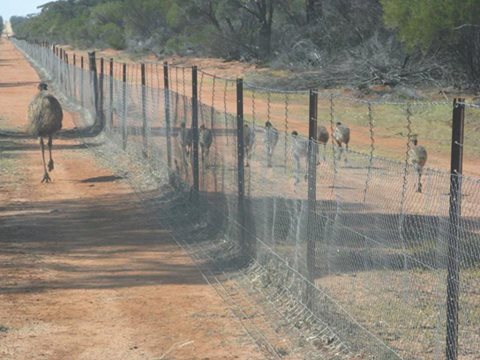
Emu father on one side of the barrier fence, his chicks on the other. Photo courtesy of Andrew Hobbs
A small win for better environmental process in WA. We welcome last week’s brave decision by WA’s Environmental Protection Authority to undertake a Public Environmental Review (PER) of the State Government’s proposal to extend the current State Barrier Fence (adding some 660kms to thethe old Rabbit Proof Fence from just east of Ravensthorpe to Cape Arid). Royalties for Regions funding for fence construction was jointly announced by the Ministers for Agriculture and Environment in 2010, apparently intending that construction would start almost immediately, with minimal consideration of ecological or cultural values. We have consistently argued for a more informed and balanced approach, and in 2013 the Department of Agriculture finally relented and commissioned some initial surveys along the proposed fence-line. While the narrow transects for these provide useful additional evidence of how globally significant the wildlife and plants are across the southern Great Western Woodlands, and have been submitted to the EPA already.
It is expected that the PER process will extend into the middle of 2017. While PER assessment is welcomed, we remain concerned that large scale and long term ecological factors, such as impact on connectivity in a time of climate change, may not be fully considered. We also remain concerned at the dodgy economics used to justify the cost, which has now blown out to at least $13million for construction alone. It’s also our understanding that the Esperance Nyungar and Ngadju communities do not support the fence.
We do recognise the significant need to better manage the interface between the Great Western Woodlands and farmland, particularly in the area east of Ravensthorpe where the existing Barrier Fence funnels kangaroos, emus and dingos for some hundreds of kilometres onto a few existing farms. Rather than see more investment in outdated and cruel barriers to wildlife movement, it seems to us that the taxpayer would get much better value by investing in Nyungar and Ngadju Ranger programs to actively manage the Woodlands and their interface with farmland, providing not only long term integrated management of species that are of concern to farmers, such as dingos and emus, but also able to tackle the spread of weeds and feral animals, protect important sites and provide ongoing fire management.



 Protecting and managing habitat
Protecting and managing habitat